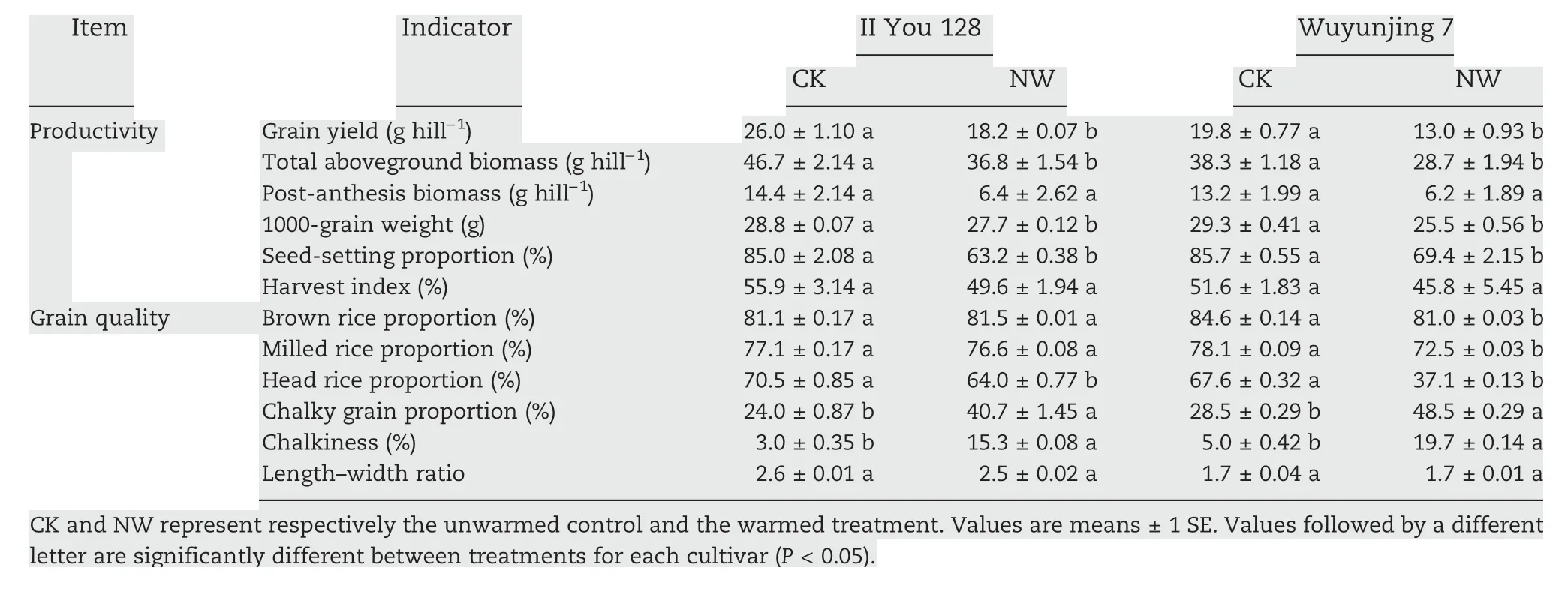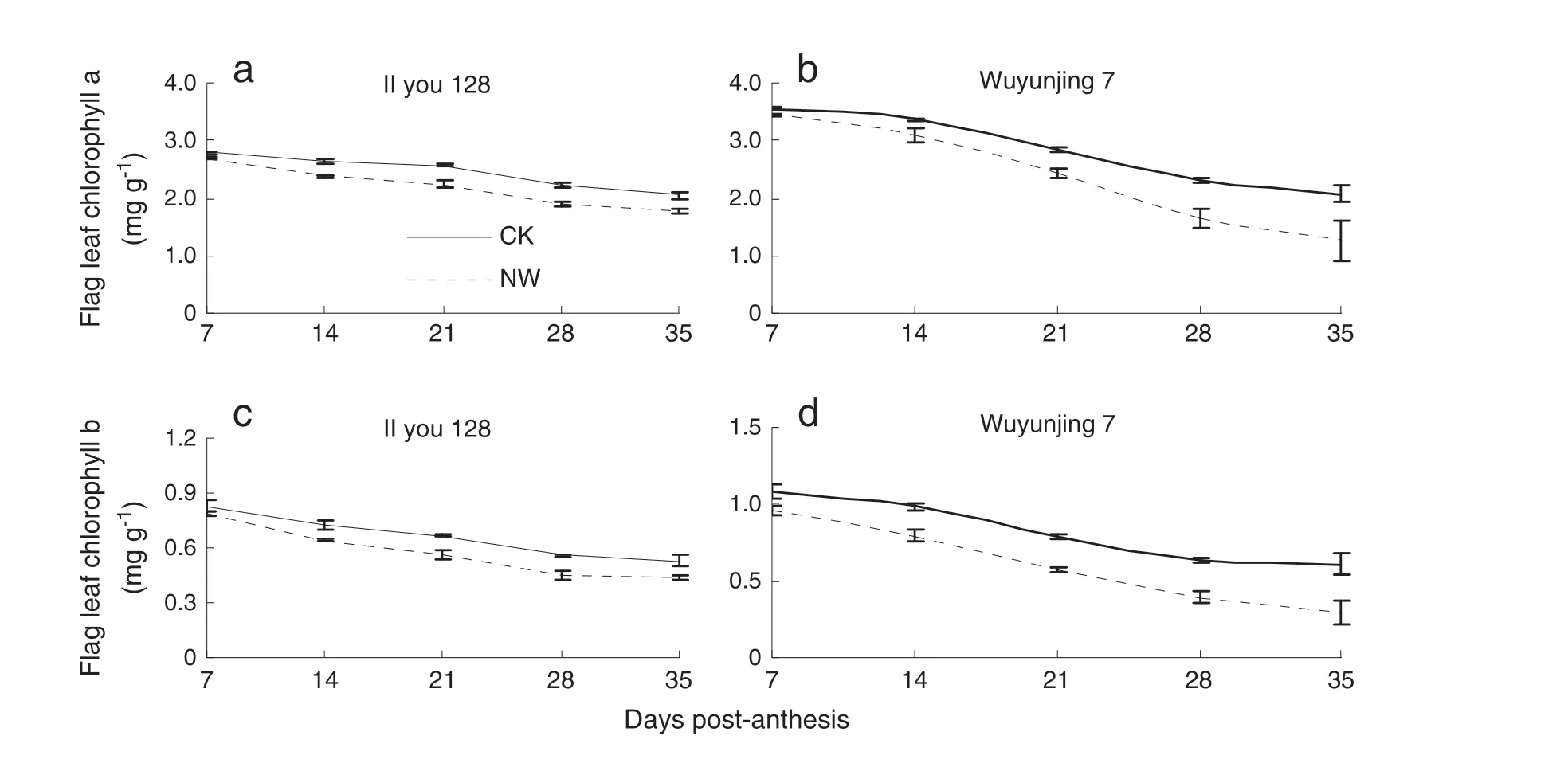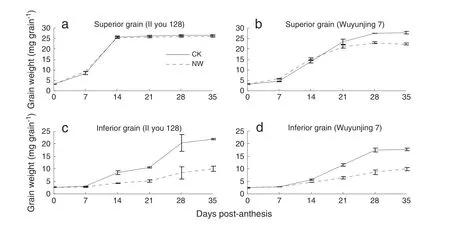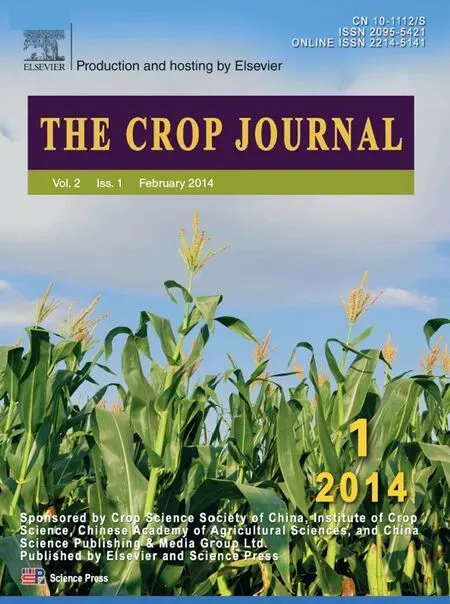Impacts of nighttime post-anthesis warming on rice productivity and grain quality in East China
Wenjun Dong*,Jin Chen,Lili Wng,Yunlu Tin,Bin Zhng,Yongi Li,Ying Meng,Chunrong Qin,Ji Guo
aInstitute of Farming and Cultivation,Heilongjiang Academy of Agricultural Sciences,Harbin 150086,China
bInstitute of Applied Ecology,Nanjing Agricultural University,Nanjing 210095,China
cInstitute of Wetland Research,Chinese Academy of Forestry,Beijing 100091,China
1.Introduction
Global mean air temperature has increased by about 0.74 °C during the past 100 years,and is predicted to increase by 2.0–5.4 °C by the end of 2100 [1].The elevation in the daily minimum temperature has been and will remain greater than that of the daily maximum temperature [2].An average annual increase in grain production of 44 million metric tons is required to meet worldwide food demands by 2050 [3,4].Given that temperature is a key factor determining crop yield and quality,the anticipated warming may strongly affect future food security [5,6].Rice is one of the most important crops and a primary food source for more than half of the world's population,and more than 90% of the world's rice is produced and consumed in Asia[7].Thus,quantifying the impact of daily minimum temperature elevation on rice growth in Asia may assist in developing strategies for cropping adaptation to future climatic warming.
Many uncertainties remain in the quantification of warming impacts on rice production,owing to insufficient understanding of rice growth response to the predicted warming [8].For example,some studies have found that warming could enhance crop photosynthesis rate through a respiration-driven reduction in leaf carbohydrate concentration,likely resulting in unchanged biomass production [9].Other studies have demonstrated that warming reduced the leaf photosynthesis rate and stimulated the night respiration rate,resulting in significant decreases in crop biomass production [10].Most previous warming experiments have been conducted with an all-day warming regime,though the known and predicted elevations of the daily minimum temperature are higher than those of the daily maximum temperature.Warming at daytime or at nighttime can cause great differences in diurnal temperature range(DTR),which in turn will result in different impacts on crop growth and yield formation [11].Thus,the evidence from previous warming experiments may not fully represent the actual responses of rice growth to the anticipated warming.In addition,warming-induced heat stress of rice growth occurs frequently during the post-anthesis phase,suggesting that post-anthesis warming at nighttime may occur more frequently and have greater impacts on rice production.Accordingly,it is desirable to quantify rice growth responses to nighttime post-anthesis warming.
East China is one of the most important rice cropping areas in Asia,and is predicted to warm by about 2.2 °C over the next 50 years with a faster nighttime than daytime increase[12].In the present study,we conducted a warming experiment in Nanjing,Jiangsu province,China.Our objectives were to investigate the responses of rice growth and grain quality to nighttime warming during the post-anthesis phase.
2.Materials and methods
A pot culture experiment was conducted on the campus of Nanjing Agricultural University,Nanjing,Jiangsu province,China(32 02′ N,118 52′ E,and 11 m a.s.l.) in 2010.The campus is located in the northern subtropical monsoon climate region.This experiment involved two treatments: post-anthesis warming at nighttime and an unwarmed control.Two leading cultivars,II You 128 (indica rice) and Wuyunjing 7(japonica rice),were tested.There were 30 pots for each treatment of each variety.
The plastic pots were 25.0 cm in inside diameter,22.0 cm in height,and 0.2 cm in thickness.Each pot contained 7.5 kg of dry brunisolic soil (Alfisol in USA-ST) with sand,silt,and clay proportions of respectively 0.5%,75.3% and 24.2%.The soil was collected from the plow layer (0–20 cm) of a rice field at the Nanjing experiment station,Nanjing Agricultural University.Other properties of this soil were as follows:total N 2.52 g kg-1,total P 0.60 g kg-1,total K 14.00 g kg-1,available P 166.22 mg kg-1,available K 165.03 mg kg-1,and soil organic C 8.24 g kg-1.
The warming facility was a controlled-environment chamber (PQS-3,Southeast Instrument Co.,Ltd.,Ningbo,China),4.5 m × 1.5 m × 1.7 m (length × width × height) in size.The air temperature and relative humidity in the chamber were controlled using electric resistance heaters and a bubbling system.The air temperature in the chamber at nighttime(19:00 to 7:00) was maintained at 25–28 °C with a wind speed of 0.5 m s-1.The relative humidity was maintained at 75%–85%,similar to that of the unwarmed control environment.The air temperatures in the rice canopy in the chamber and the ambient environment were monitored every 10 min at night with a Thermo Recorder (ZDR-41,Zeda Instrument Co.,Ltd.,Hangzhou,China).The differences in rice canopy air temperatures at nighttime were automatically adjusted to approximately 3.0–3.5 °C higher in the chamber than in the ambient control environment(Fig.1).
Germinated rice seeds were sown in plastic boxes on 13 May 2010.After one month of growth,rice seedlings were transplanted to the plastic pots.There were two holes seedlings for each pot and two seedlings for each hole.Fertilizer was applied as 0.75 g N,0.38 g P2O5and 0.38 g K2O per pot.All of the P2O5and K2O and 50%of the N were applied as basal dressing.Half of the remaining N was applied as side dressing at the early tillering stage in the latter of June,and the rest of the N was applied at panicle initiation in the latter part of August.Water depth in all pots was maintained at about 5 cm above the soil surface during the entire rice growing cycle.
All pots were kept under ambient conditions outside the chamber before rice anthesis.During the post-anthesis phase,half of the pots were placed in the chamber for 12 h at night(from 19:00 to 7:00) and moved outside after 7:00 every day.The warmed and unwarmed pots were kept in the same ambient environment at the daytime from 7:00 to 19:00 every day during the post-anthesis phase.
At the anthesis and maturity stages,plants from three pots of each treatment were sampled and divided into leaf,stem,and panicle.All plant samples were oven-dried at 80 °C for 24 h and weighed.Post-anthesis biomass accumulation was calculated as the difference in total aboveground dry matter between the anthesis stage and harvest.Nine pots from each treatment were harvested to determine grain yield and its components.
At 0,21 and 35 days post-anthesis (DPA),fifteen flag leaves of main stems were selected for measurements of net photosynthesis rate (from 9:00 to 11:00)and night respiration rate (from 22:00 to 23:00) with a portable photosynthesis system(Li-6400;Li-Cor,Inc.,Lincoln,NE,USA).Another fifteen flag leaves were sampled in each treatment at 7,14,21,28 and 35 DPA for measurements of chlorophyll a and b contents by the method of aqueous acetone extraction [13].
At the anthesis stage,approximately 200 rice panicles were labeled for the determination of grain filling rate.Fifteen panicles were taken from each treatment on 0,7,14,21,28 and 35 DPA.Kernels were stripped from panicles and divided into superior (those borne in the upper half of the panicle) and inferior (those borne in the lower half of the panicle) kernels [14].All grain was oven-dried at 80 °C for 24 h and weighed.
After being harvested,rice grain was stored at room temperature for three months before quality testing.Grain milling and appearance quality indexes (brown rice,milled rice,head rice,and chalky grain proportions,chalkiness,and length–width ratio) were determined according to the National Standard of China,High Quality Paddy,GB/T 17891-1999.

Fig.1-Variation of air temperature at rice canopy at nighttime during the post-anthesis phase in warmed and unwarmed treatments of the two cultivars II You 128(a)and Wuyunjing 7(b).CK and NW represent respectively the unwarmed control and the nighttime warmed treatment.
Statistical analysis was performed by ANOVA with SPSS 11.5(SPSS Inc.,Chicago,IL,USA).Differences were assigned as significant at P <0.05.
3.Results
Post-anthesis warming at nighttime significantly decreased rice aboveground biomass accumulation and grain yield(Tables 1 and 2).Warming decreased the accumulations of total aboveground biomass and post-anthesis biomass by 21.2% and 55.6% for II You 128 and by 24.9% and 53.2% for Wuyunjing 7 (P <0.05).Grain yield and 1000-grain weight were reduced by 30.0% and 3.7%,respectively,for II You 128 and by 34.3% and 12.8% for Wuyunjing 7 (P <0.05).The seed setting rates of II You 128 and Wuyunjing 7 were 25.7% and 19.1%,respectively,lower in the warmed treatment than the unwarmed control (P <0.05).Significant differences in biomass accumulation and grain yield were found between the two cultivars(P <0.05),and higher impacts of warming on rice productivity were found for Wuyunjing 7 than for II You 128.
Post-anthesis warming at nighttime significantly reduced rice grain milling and appearance quality and the two varieties showed significant differences in their milling quality response to warming (Tables 1 and 2).Warming decreased the milling quality indicators of brown rice,milled rice and head rice proportion by 4.3%,7.2% and 45.1% for Wuyujing 7 (P <0.05),whereas there were no significant reductions in these indicators for II You 128.The appearance quality indicators of chalky grain proportion and chalkiness were respectively 69.6% and 410.0%higher for II You 128 and 70.2%and 294.0%for Wuyujing 7 in warmed than in unwarmed control plots (P <0.05).No significant differences were found in length–width ratio for either variety between the warmed and unwarmed treatments.
Post-anthesis warming at nighttime tended to reduce flag leaf chlorophyll content,especially for Wuyunjing 7(Fig.2-b,d).The contents of chlorophyll a and b were reduced under warming by an average of 10.7% and 13.6%,respectively,for II You 128 and by 16.0% and 26.2% for Wuyunjing 7 (Fig.2).A greater decrease in flag leaf chlorophyll content was found for Wuyunjing 7 than for II You 128.

Table 1-Plant productivity and grain quality in warmed and unwarmed treatments.
Post-anthesis warming at nighttime reduced leaf net photosynthesis and stimulated night respiration rates(Fig.3),especially 21 days after flowering (P <0.05).During grain filling,the net photosynthetic rate of the flag leaf decreased by averages of 14.2%and 16.4%for II You 128 and Wuyunjing 7,respectively(Fig.3-a).The night respiration rate was stimulated by,on average,32.2%and 34.6% during the post-anthesis phase for II You 128 and Wuyunjing 7(Fig.3-b).

Table 2-Significance values and degrees if freedom in ANOVA analysis(two-way).
Post-anthesis warming at nighttime induced significant decreases in the filling rate of inferior grain,with that of superior grain remaining almost unchanged (Fig.4).For II You 128,warming significantly decreased the filling rate of inferior grain by an average of 50.2% over the post-anthesis phase(P <0.05;Fig.4-c),whereas there was no obvious impact on filling of superior grain.For Wuyunjing 7,warming induced a slight decrease in the filling rate of superior grain(Fig.4-b),and significantly decreased the filling rate of inferior grain,by an average of 39.7%(P <0.05;Fig.4-d).
4.Discussion
The anticipated nighttime warming may reduce rice yield by stimulating nighttime respiration[9,15,16].In the present study,post-anthesis warming at nighttime stimulated the flag leaf nighttime respiration rate while decreasing the photosynthesis rate by reducing the chlorophyll a and b contents,resulting in significant decreases in the accumulation of aboveground rice biomass,especially during post-anthesis phase.Although net photosynthesis was slightly lower under nighttime warming at the very beginning of the treatment,there was no significant difference between the nighttime warmed plots and unwarmed control.Many studies have shown that post-anthesis biomass production contributes the main portion of crop grain carbohydrate accumulation [17,18].A warming-induced decrease in post-anthesis biomass production greatly depressed the filling rate of rice kernels,especially inferior kernels,resulting in a large decrease in the 1000-grain weight.Warming can also decrease rice pollen activity and spikelet fertilization[19–21],an effect confirmed by the significant decrease in the seed setting rate in our study.Our results demonstrate that post-anthesis warming at nighttime may lead to a large loss in rice yield owing to warming-induced poorer grain filling and seed setting rates in East China and even in East Asia.

Fig.2-Contents of flag leaf chlorophyll a(a,b)and chlorophyll b(c,d)during the post-anthesis phase in warmed and unwarmed treatments.CK and NW represent respectively the unwarmed control and the nighttime warmed treatment.Values are means ± 1 SE.
Warming-induced poorer grain filling can not only decrease grain weight but affect grain quality,especially milling and appearance quality.Recent studies have shown that rice grain chalkiness exhibited a positive quadratic relationship with nighttime temperature and that head rice proportion was linearly and inversely correlated with nighttime temperature during the post-anthesis phase [22,23].These studies suggest that post-anthesis warming at nighttime can reduce rice appearance quality,an effect confirmed by the significant increases of chalky grain proportion and chalkiness in the present study.Other studies have shown that high night temperatures could lessen rice grain weight,length,and width [24,25],and decrease grain amylose content and flour gel consistency[26],suggesting that nighttime warming can reduce rice milling quality.This effect too is confirmed by the significant decreases in the proportions of brown rice,milled rice,and head rice caused by warming in the present study.

Fig.3-Net photosynthetic rate(a)and night respiration rate(b)of the flag leaf in warmed and unwarmed treatments during the post-anthesis phase.CK and NW represent respectively the unwarmed control and the warmed plots.Values are means ± 1 SE.DPA denotes days post-anthesis.

Fig.4-Grain filling dynamics of the superior grain(a,b)and inferior grain(c,d)in warmed and unwarmed treatments.CK and NW represent respectively the unwarmed control and the warmed plots.Values are means ± 1 SE.
Significant differences in nighttime warming impacts were found between rice varieties in this study.Warming-led negative effects on rice grain yield and quality were higher for Wuyunjing 7 than II You 128,suggesting that indica rice possesses greater adaptation capacity to temperature elevation than japonica rice.Japonica rice originates mainly in relatively lower-temperature regions,whereas indica rice originates in higher-temperature regions.After long adaptation to its growing environment,indica rice carries greater adaptation capacity and resistance to warming than japonica rice [19,27].This difference offers an opportunity to adapt to climatic warming by adjusting the spatial distribution of rice varieties.Recently,with the aim of fully investigating warming-induced increases in climatic potential,an ongoing program of alternating indica rice with japonica rice has been conducted in rice–wheat cropping areas in China.On one hand,this alternation may increase rice yield potential by prolonging the growing cycle,because of the higher resistance of japonica than indica rice to low temperature [20].On the other hand,our results indicate that this alternation may also decrease rice yield potential,owing to the lower resistance of japonica than indica rice to high temperature.Although the anticipated warming may prolong the rice growth period,it may also increase heat stress to grain filling,especially in rice–wheat cropping areas [28].Thus,the adjustment of rice variety selection needs to be performed carefully according to the prevailing temperatures in each specific area.
Interestingly,greater negative impacts of nighttime warming were found on the filling rate of inferior than on that of superior grain,especially for the indica rice II You 128.Previous studies have also shown that the filling rate was significantly higher for superior than for inferior grain [29].Rice superior grain is characterized by larger vascular bundles in the panicle and stronger filling activity than inferior grain,suggesting greater resistance of superior than of inferior grain to environmental changes such as warming.In addition,post-anthesis warming at nighttime could decrease the grain-filling rate of inferior grain,an effect that may be closely associated with the activities of GS and GOGAT(the key enzymes of protein synthesis)and of ADPG-PPase,SSS and SBE(the key enzymes of starch synthesis)[30].The significant differences in warming impacts between superior and inferior grain have important implications for super-rice cropping.Owing to its great advantages in biomass production and spikelet formation,super rice has been considered as one hope to further increase rice yield under future climate patterns in China [31,32].However,recent studies have shown that super rice has some disadvantages,especially the relatively lower seed-setting rate and poorer filling rate of inferior grains than found in“normal”rice varieties[14,33].Our results indicate that the anticipated nighttime warming during post-anthesis phase may greatly decrease rice yield by reducing the seed-setting rate and inferior grain filling rate.Thus,there may be a great risk of warming-induced decrease in rice yield if existing normal rice varieties are alternated with super rice varieties under future climate patterns.
5.Conclusions
Post-anthesis warming at nighttime will reduce not only rice grain yield but grain quality in East China.The reduction in grain yield can be attributed mainly to reductions in seed-setting rate and 1000-grain weight,and that in grain quality is likely attributable to the poor filling of inferior grains.Nighttime warming during the post-anthesis phase stimulated the rice nighttime respiration rate and reduced the photosynthesis rate.There were great differences in response between rice grain types and between rice varieties.Post-anthesis warming at nighttime greatly depressed the filling rate of inferior kernels,while that of superior kernels remained almost unchanged.The above findings indicate that global warming may cause large losses of rice yield and serious declines in rice quality,and that the adjustment of cultivar type may present one means of adaptation to future climate patterns to preserve food security in East China.
This work was supported by the National Key Technology Support Program of China(2011BAD16B14),the Chinese Natural Science Foundation(30771278),and the Program for New Century Excellent Talents in University(NCET-05-0492).
[1] D.I.Arnon,Copper enzymes in isolated chloroplasts.Polyphenoloxidase in Beta vulgaris,Plant Physiol.24(1949)1–15.
[2] IPCC,Climate change 2007: the physical science basis,Contribution of Working Group I to the Fourth Assessment Report of the Intergovernmental Panel on Climate Change,Cambridge University Press,Cambridge,2007.
[3] D.R.Easterling,B.Horton,P.D.Jones,T.C.Peterson,T.R.Karl,D.E.Parker,M.J.Salinger,V.Razuvayev,N.Plummer,P.Jamason,C.K.Folland,Maximum and minimum temperature trends for globe,Science 277 (1997) 364–367.
[4] M.Tester,P.Langridge,Breeding technologies to increase crop production in a changing world,Science 327 (2010)818–822.
[5] J.Wart,K.C.Kersebaum,S.Peng,M.Milner,K.G.Cassman,Estimating crop yield potential at regional to national scales,Field Crop Res.143 (2013) 34–43.
[6] U.Lele,Food security for a billion poor,Science 326 (2010)1554.
[7] D.B.Lobell,W.Schlenker,J.Costa-Roberts,Climate trends and global crop production since 1980,Science 333 (2011)616–620.
[8] G.S.Khush,What it will take to feed 5.0 billion rice consumers in 2030,Plant Mol.Biol.59 (2005) 1–6.
[9] F.N.Tubiello,J.F.Soussana,S.M.Howden,Crop and pasture response to climate change,Proc.Natl.Acad.Sci.U.S.A.104(2007) 19686–19690.
[10] M.H.Turnbull,R.Murthy,K.L.Griffin,The relative impacts of daytime and night-time warming on photosynthetic capacity in Populus deltoids,Plant Cell Environ.25 (2002) 1729–1737.
[11] I.Oh-e,K.Saitoh,T.Kuroda,Effects of high temperature on growth,yield and dry-matter production of rice grown in the paddy field,Plant Prot.Sci.10(2007) 412–422.
[12] D.B.Lobell,Changes in diurnal temperature range and national cereal yields,Agric.For.Meteorol.145 (2007)229–238.
[13] G.Xiao,Q.Zhang,Y.Yao,H.Zhao,R.Wang,H.Bai,F.Zhang,Impact of recent climatic change on the yield of winter at low and high altitudes in semi-arid northwester China,Agric.Ecosyst.Environ.127 (2008) 37–42.
[14] T.Ishimaru,T.Hirose,T.Matsuda,A.Goto,K.Takahashi,H.Sasaki,T.Terao,R.Ishii,R.Ohsugi,T.Yamagishi,Expression patterns of genes encoding carbohydrate-metabolizing enzymes and their relationship to grain filling in rice (Oryza sativa L.): comparison of caryopses located at different positions in a panicle,Plant Cell Physiol.46(2005) 620–628.
[15] S.P.Peng,J.L.Huang,J.E.Sheehy,R.C.Laza,R.M.Visperas,X.H.Zhong,G.S.Centeno,G.S.Khush,K.G.Cassman,Rice yields decline with higher night temperature from global warming,Proc.Natl.Acad.Sci.U.S.A.101 (2004) 9971–9975.
[16] J.R.Welch,J.R.Vincent,M.Auffhammer,P.F.Moya,A.Dobermann,D.Dawe,Rice yields in tropical/subtropical Asia exhibit large but opposing sensitivities to minimum and maximum temperatures,Proc.Natl.Acad.Sci.U.S.A.107(2010) 14562–14567.
[17] L.T.Evans,R.A.Fischer,Yield potential: its definition,measurement,and significance,Crop Sci.39(1999)1544–1551.
[18] D.A.Ntanos,S.D.Koutroubas,Dry matter and N accumulation and translocation for indica and japonica rice under Mediterranean conditions,Field Crop Res.74(2002)93–101.
[19] B.Zhang,W.Rui,J.Zheng,B.Zhou,F.Yang,W.Zhang,Responses of pollen activity and seed setting of rice to high temperature of heading period,Acta Agron.Sin.33(2007)1177–1181(in Chinese with English abstract).
[20] R.Wassmann,S.V.K.Jagadish,S.Heuer,A.Ismail,E.Redona,R.Serraj,R.K.Singh,G.Howell,H.Pathak,K.Sumfleth,Climate change affecting rice production: the physiological and agronomic basis for possible adaptation strategies,Adv.Agron.101 (2009) 59–122.
[21] Z.W.Rang,S.V.K.Jagadish,Q.M.Zhou,P.Q.Craufurd,S.Heuer,Effect of high temperature and water stress on pollen germination and spikelet fertility in rice,Environ.Exp.Bot.70(2011) 58–65.
[22] A.Ambardekar,T.Siebenmorgen,P.Counce,S.Lanning,A.Mauromoustakos,Impact of field-scale nighttime air temperatures during kernel development on rice milling quality,Field Crop Res.122 (2011) 179–185.
[23] S.B.Lanning,T.J.Siebenmorgen,P.A.Counce,A.A.Ambardekar,A.Mauromoustakos,Extreme nighttime air temperatures in 2010 impact rice chalkiness and milling quality,Field Crop Res.124 (2011) 132–136.
[24] A.R.Mohammed,L.Tarpley,Effects of high night temperature and spikelet position on yield-related parameters of rice(Oryza sativa L.)plants,Eur.J.Agron.33(2010)117–123.
[25] A.R.Mohammed,L.Tarpley,Effects of night temperature,spikelet position and salicylic acid on yield and yield-related parameters of rice (Oryza sativa L.) plants,J.Agron.Crop Sci.197 (2011) 40–49.
[26] C.Lin,C.Li,S.Lin,F.Yang,J.Huang,Y.Liu,H.Lur,Influence of high temperature during grain filling on the accumulation of storage proteins and grain quality in rice (Oryza sativa L.),J.Agric.Food Chem.58(2010) 10545–10552.
[27] J.Weng,C.Chen,Differences between Indica and Japonica rice varieties in CO2exchange rates in response to leaf nitrogen and temperature,Photosynth.Res.14(1987)171–178.
[28] G.B.S.Chahal,A.Sood,S.K.Jalota,B.U.Choudhury,P.K.Sharma,Yield,evapotranspiration and water productivity of rice (Oryza sativa L.)–wheat(Triticum aestivum L.) system in Punjab(India)as influenced by transplanting date of rice and weather parameters,Agric.Water Manag.88(2007) 14–22.
[29] T.Ishimaru,T.Matsuda,R.Ohsugi,T.Yamagishi,Morphological development of rice caryopses located at the different positions in a panicle from early to middle stage of grain filling,Funct.Plant Biol.30(2003) 1139–1149.
[30] W.J.Dong,Y.L.Tian,B.Zhang,J.Chen,W.J.Zhang,Effects of asymmetric warming on grain quality and related key enzymes activities for japonica rice (Nanjing 44)under FATI facility,Acta Agron.Sin.37(2011) 832–841(in Chinese with English abstract).
[31] S.H.Cheng,J.Y.Zhuang,Y.Y.Fan,J.H.Du,L.Y.Cao,Progress in research and development on hybrid rice: a super-domesticate in China,Ann.Bot.100 (2007) 959–966.
[32] Q.Zhang,Strategies for developing green super rice,Proc.Natl.Acad.Sci.U.S.A.104 (2007) 16402–16409.
[33] J.Yang,J.Zhang,Grain-filling problem in ‘super'rice,J.Exp.Bot.61(2010) 1–5.
- The Crop Journal的其它文章
- Effect of nitrogen fertilizer on distribution of starch granules in different regions of wheat endosperm
- Induced defense responses in rice plants against small brown planthopper infestation
- Overexpression of GmDREB1 improves salt tolerance in transgenic wheat and leaf protein response to high salinity
- Establishment of the integrated applied core collection and its comparison with mini core collection in soybean(Glycine max)
- Differential microRNA expression between shoots and rhizomes in Oryza longistaminata using high-throughput RNA sequencing
- Genome-wide analysis of the WRKY transcription factor gene family in Gossypium raimondii and the expression of orthologs in cultivated tetraploid cotton

